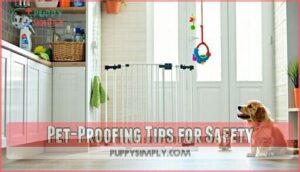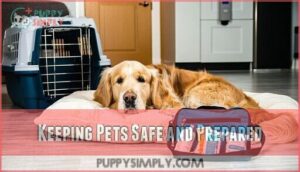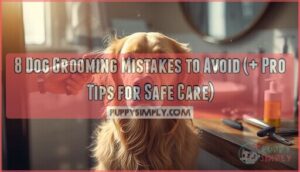This site is supported by our readers. We may earn a commission, at no cost to you, if you purchase through links.

Create emergency kits and evacuation plans for unexpected situations. Regular grooming, mental stimulation, and socialization keep pets healthy and happy. Don’t forget vaccination schedules and parasite prevention—early detection saves lives and money.
Your pet parent journey involves understanding their unique needs, from safe sleeping spaces to quality bonding time that strengthens your relationship for years ahead.
Table Of Contents
- Key Takeaways
- Essential Steps for New Pet Parents
- Daily Care Routines for Dogs
- Daily Care Routines for Cats
- Supporting Pet Health and Wellness
- Keeping Pets Safe and Prepared
- Frequently Asked Questions (FAQs)
- How do I introduce my new dog to my existing pets?
- What are some common behavioral issues in dogs and how can I address them?
- How often should I groom my dog and what grooming tools do I need?
- Can I feed my cat a vegetarian or vegan diet?
- What are some common health issues in cats and how can I prevent them?
- How do I choose between dog breeds?
- Whats the best age to adopt pets?
- How much do pets actually cost yearly?
- Can apartments accommodate larger pet breeds?
- When should I consider pet insurance coverage?
- Conclusion
Key Takeaways
- Create a safe environment first – You’ll need to pet-proof your home by removing toxic substances, securing dangerous items, and establishing safe zones before bringing your new companion home.
- Establish consistent daily routines – You must develop regular schedules for feeding, exercise, grooming, and veterinary care to keep your pet healthy and build strong bonding habits.
- Prioritize preventive healthcare – You should schedule annual vet visits, maintain vaccination schedules, and watch for early warning signs to catch health issues before they become serious problems.
- Prepare for emergencies and unexpected situations – You’ll want to create emergency kits, evacuation plans, and ensure proper identification through microchipping to protect your pet when disasters strike.
Essential Steps for New Pet Parents
Bringing home a new pet marks the start of an exciting journey. It requires proper preparation to help guarantee your furry friend’s health and happiness.
You’ll need to create a safe environment, gather essential supplies, and establish routines that support your pet’s physical and emotional well-being from day one.
Preparing Your Home for a Pet
Before bringing your furry friend home, you’ll need to create a pet-friendly home that’s both welcoming and secure. Start by establishing safe zones where your pet can retreat and relax without disturbance.
- Remove toxic hazards like chocolate, cleaning supplies, and small objects that could cause choking
- Designate training spaces with easy-to-clean surfaces for house-training accidents
- Consider allergy considerations by choosing hypoallergenic bedding and avoiding strong air fresheners
Multi-pet homes require extra planning to prevent territorial disputes.
Must-Have Accessories and Supplies
Your pet supply checklist starts with the basics: food and water bowls, comfortable pet carriers, and durable chew toys. Add essential grooming tools for regular maintenance.
Interactive food puzzles keep minds sharp while smart pet feeders manage portions.
Stock up on pet cleaning supplies for accidents. These accessories create a foundation for your pet’s daily needs and long-term happiness.
Pet-Proofing Tips for Safety
Like childproofing a home, creating a pet-friendly home requires vigilance. Secure cabinets containing house cleaning supplies and toxic plants beyond reach. Use cord management to prevent chewing hazards. Install window safety locks and gates. The childproofing overlap means many safety measures protect both kids and pets.
Store pet cleaning supplies separately from household chemicals to avoid mix-ups and reduce pet risks.
Daily Care Routines for Dogs
You’ll need to establish consistent daily routines that keep your dog healthy, happy, and well-behaved. These simple habits, including regular exercise, proper nutrition, and basic grooming, form the foundation of responsible pet ownership and help prevent common health issues before they start.
Exercise and Engaging Activities
Daily dog exercise isn’t just about burning energy—it’s about building happiness. Match activity levels to your dog’s breed specifics and age.
Interactive toys provide mental enrichment while fetch delivers exercise benefits. Rotate between physical activity and mental stimulation.
Play sessions strengthen your bond while keeping minds sharp and bodies healthy.
Balanced Nutrition and Fresh Water
After establishing your dog’s exercise routine, nutrition becomes the cornerstone of their health. Your dog needs balanced portions with quality pet food ingredients that support nutrient absorption. Check for food allergies by monitoring reactions to new foods.
Portion control prevents obesity, while proper hydration importance can’t be overstated—fresh water should always be available. Puppy food contains higher protein for growing dogs. balanced diet tailored pet nutrition is essential, so consider a diet tailored to your pet’s needs.
Dietary supplements aren’t usually necessary with well-balanced diets.
Grooming for Health and Comfort
Brushing your dog’s coat health starts with choosing the right grooming tools for their fur type. Weekly brushing prevents matting and distributes natural oils.
Don’t forget nail trimming every few weeks and dental hygiene with dog-safe toothpaste. Regular ear cleaning prevents infections, while watching for skin conditions keeps your pup comfortable and healthy.
Daily Care Routines for Cats
Your cat’s daily routine doesn’t have to be complicated, but consistency makes all the difference for their health and happiness.
Simple habits like regular grooming, fresh water, and interactive play will keep your feline friend thriving while strengthening your bond together.
Grooming to Minimize Shedding
Regular brushing transforms your cat’s coat from a fur-covered furniture nightmare into manageable beauty. Shedding breeds like Maine Coons need daily attention, while short-haired cats thrive with weekly sessions.
Proper brushing techniques prevent matting and distribute natural oils throughout your cat’s coat.
- Use slicker brushes for long-haired cats
- Choose rubber grooming tools for short coats
- Brush against hair growth, then with it
- Bathe monthly using cat-specific shampoos
- Add omega-rich foods to reduce excessive shedding
Indoor Enrichment and Stimulation
Something every cat parent knows—your feline needs more than food and sleep. Creating space with puzzle toys and training games keeps your pet’s mind sharp. Sensory enrichment through creative play prevents boredom-induced behaviors. Indoor agility courses transform your home into a feline playground, supporting pets’ emotional wellbeing through mental stimulation and enrichment.
| Activity Type | Examples | Benefits |
|---|---|---|
| Puzzle Toys | Treat dispensers, food puzzles | Slows eating, mental challenge |
| Creative Play | Feather wands, laser pointers | Exercise, hunting instincts |
| Training Games | Clicker training, trick teaching | Bonding, cognitive development |
| Indoor Agility | Cat trees, tunnels, shelves | Physical fitness, confidence |
Clean Water and Food Bowls
Your cat’s food and water bowls deserve more attention than you might think. Bacteria buildup and water contamination can harm your feline friend’s health. Choose bowl material safety over style—stainless steel or ceramic beats plastic every time.
- Wash daily to prevent bacteria from turning mealtime into a health risk
- Replace water twice daily for freshness and proper hydration
- Consider elevated bowls for senior cats or those with arthritis
Clean bowls support your well-balanced diet efforts and keep pet food ingredients fresh.
Supporting Pet Health and Wellness
Your pet’s health depends on consistent preventive care and early problem detection.
You’ll keep your furry friend healthiest through regular vet visits, proper nutrition, and recognizing warning signs before they become serious issues.
Routine Veterinary Visits and Preventive Care
Beyond daily grooming comes your pet’s healthcare foundation. Your vet becomes your partner in preventive care, catching problems before they escalate. Annual wellness exams establish health baselines, while vaccination schedules and parasite prevention protect against disease.
| Care Component | Frequency |
|---|---|
| Wellness Exams | Annual (senior pets: every 6 months) |
| Core Vaccinations | Annual or triennial per vet guidance |
| Parasite Prevention | Year-round monthly treatments |
| Dental Cleanings | As recommended by veterinarian |
| Blood Work Screening | Annual for early detection |
Early detection saves lives and money—1 in 7 young pets show health issues despite appearing healthy. These tests can help with early disease detection, which allows for less invasive treatments.
Recognizing and Addressing Health Issues
You’re your pet’s first line of defense against health issues. Early detection through daily observation can save lives—watch for subtle behavioral changes that signal trouble. Senior care becomes essential as pets age, requiring closer monitoring for breed predispositions to specific conditions.
You’re your pet’s first line of defense—watch for subtle changes that signal trouble before they become serious health issues
- Sudden appetite loss or excessive thirst signals serious health problems
- Limping, difficulty breathing, or lethargy demands immediate veterinary care
- Changes in bathroom habits often indicate underlying health and wellbeing issues
- Emergency symptoms like seizures or collapse require instant professional attention
Mental Stimulation and Socialization
Three simple activities keep your pet’s mind sharp and spirits high. Puzzle feeders transform mealtime into training games, while interactive toys serve as excellent boredom busters.
Regular socialization benefits your pet’s emotional wellbeing by building confidence through new experiences. Mental stimulation and enrichment prevent destructive behaviors, creating stronger socialization and bonding between you both.
Remember, a busy mind equals a happy pet who thrives through purposeful play.
Keeping Pets Safe and Prepared
You’ll want to create a safe home environment and prepare for unexpected situations to protect your furry family members. Smart planning includes pet-proofing dangerous areas, ensuring proper identification, and having emergency supplies ready when you need them most.
Creating a Hazard-Free Environment
Safety and Prevention starts with smart choices around your home. Think childproofing parallels – what harms kids often threatens pets too. Create a pet-friendly home by addressing these pet risks:
- Remove toxic plants like lilies and azaleas from reach
- Secure chemicals in locked cabinets
- Practice cord management to prevent chewing hazards
- Install window safety screens to prevent falls
Your safe space protects curious explorers year-round.
Microchipping and Identification
Losing your furry friend can turn your world upside down. Microchip technology offers permanent identification that can’t fall off like collar tags. Registration importance can’t be overstated—update your contact info immediately after moving. ID tags complement microchips perfectly for quick visual identification.
| Recovery Method | Success Rate | Time to Reunion |
|---|---|---|
| Microchip your dog | 52% | 2-3 days |
| Dog tags only | 22% | Same day |
| Both combined | 74% | 1-2 days |
Dog microchip insertion takes seconds at your vet’s office. International travel requires specific chip frequencies, so check destination requirements beforehand.
Emergency Planning for Pet Owners
While microchipping keeps pets identifiable, Disaster Preparedness turns identification into action when emergencies strike. Most pet owners haven’t created thorough Evacuation Plans despite living in disaster-prone areas. Building a Pet Firstaid Kit and organizing Medical Records protects your furry family when minutes matter.
Here’s your Emergency Preparedness checklist:
- Assemble supplies – Food, water, medications, Medical Records in waterproof containers
- Map evacuation routes – Research pet-friendly hotels and shelters along your path
- Practice loading pets – Reduce panic by drilling carrier/vehicle entry regularly
- Arrange backup care – Coordinate with neighbors for Pet Care if you’re separated
- Consider Insurance Options – Protect against unexpected Veterinary Care costs during disasters
Frequently Asked Questions (FAQs)
How do I introduce my new dog to my existing pets?
Start introducing your new dog to existing pets in neutral territory, not at home. Keep both animals leashed and supervised, rewarding calm behavior with treats. Gradually progress inside once they’re comfortable together.
What are some common behavioral issues in dogs and how can I address them?
Research shows over 99% of dogs exhibit behavioral issues , with separation anxiety, aggression, and fear being most common.
You’ll tackle these through positive reinforcement training, consistent routines, and patience—most problems stem from boredom or stress, not defiance.
How often should I groom my dog and what grooming tools do I need?
Brush your dog weekly for short coats, daily for long-haired breeds. You’ll need a slicker brush, nail clippers, dog shampoo, and toothbrush. Regular grooming keeps your pup healthy and happy.
Can I feed my cat a vegetarian or vegan diet?
While your heart’s in the right place, cats can’t thrive on vegetarian diets. They’re obligate carnivores needing nutrients like taurine from meat.
Synthetic options exist but require careful veterinary oversight for safety.
What are some common health issues in cats and how can I prevent them?
Common cat health issues include dental disease, obesity, kidney disease, and respiratory infections. Prevent them through annual vet checkups, proper dental care, weight management, and keeping vaccinations current.
How do I choose between dog breeds?
Picking your perfect four-legged match feels overwhelming? Consider your lifestyle, activity level, living space, and grooming preferences first. Match breeds to your daily routine and family needs.
Whats the best age to adopt pets?
You’ll find the sweet spot for adoption varies by pet type. Puppies do best at 8-10 weeks when they’re primed for socialization, while kittens shine at 10-12 weeks.
Consider adult pets too—they’re calmer, house-trained, and their personalities are already set.
How much do pets actually cost yearly?
Pet ownership costs range from $1,200–$4,300 annually for dogs. You’ll budget around $115–$440 monthly for dogs, $65–$290 for cats, depending on your pet’s size, breed, health needs, and lifestyle preferences.
Can apartments accommodate larger pet breeds?
Yes, apartments can accommodate larger breeds, but you’ll face weight limits (usually 20-50 pounds) and breed restrictions. Larger dogs over 25-30 pounds tend to be affected greatly by apartment policies.
Though pet-friendly options exist, proper research is necessary to find suitable accommodations.
When should I consider pet insurance coverage?
Insurance costs average $62 monthly for dogs—that’s nearly $750 annually. You’ll want coverage while your pet’s still young and healthy, before any pre-existing conditions develop.
Conclusion
Parenting pets properly requires patience, persistence, and plenty of preparation. You’ve learned the fundamentals through this thorough pet parents guide—from daily care routines to emergency planning.
Remember that each animal has unique needs, so stay flexible and observant. Your dedication creates lasting bonds while ensuring your companion’s health and happiness.
Keep learning, stay consistent with routines, and trust your instincts as a caring pet parent.
- https://www.petpalaceresort.com/100-pet-care-industry-statistics/
- https://www.avma.org/resources-tools/reports-statistics/us-pet-ownership-statistics
- https://www.pawsenroute.com/post/the-millennial-pet-parenting-trend-how-a-generation-is-redefining-pet-ownership
- https://www.dogster.com/statistics/pets-and-family-dynamics-statistics
- https://flamingopetclinic.com/top-aspects-of-responsible-pet-ownership/















